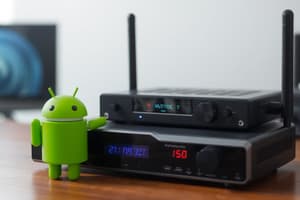Podcast
Questions and Answers
What is the main purpose of mobile applications?
What is the main purpose of mobile applications?
- To complicate user interactions
- To slow down technological advancement
- To create engaging and frictionless experiences (correct)
- To limit the functionalities of smartphones
What does Android development focus on?
What does Android development focus on?
- Ignoring Google's guidelines
- Prioritizing cluttered interfaces
- Following Material Design Guidelines (correct)
- Using outdated design principles
What do app designers aim to achieve in terms of usability?
What do app designers aim to achieve in terms of usability?
- Randomly incorporate design elements
- Create complex and confusing interfaces
- Create applications that are easy to use (correct)
- Ignore consistency across platforms
Which design principle is emphasized in mobile app design?
Which design principle is emphasized in mobile app design?
What are Android developers encouraged to align with?
What are Android developers encouraged to align with?
Why is clear language important in mobile applications?
Why is clear language important in mobile applications?
What is a key consideration when designing for poor connectivity?
What is a key consideration when designing for poor connectivity?
Which design element should be avoided when creating links in a mobile app?
Which design element should be avoided when creating links in a mobile app?
What should be the priority in terms of appearance to enhance user experience?
What should be the priority in terms of appearance to enhance user experience?
Which aspect is essential for designing accessible mobile applications?
Which aspect is essential for designing accessible mobile applications?
What is a recommended strategy for promoting user engagement in mobile apps?
What is a recommended strategy for promoting user engagement in mobile apps?
Which design trend focuses on using AI to enhance user experiences?
Which design trend focuses on using AI to enhance user experiences?
Flashcards are hidden until you start studying
Study Notes
Mobile Applications and Design: A Comprehensive Guide
Mobile applications have revolutionized the way we interact with technology, offering engaging and frictionless experiences to millions of users worldwide. This article focuses on the subtopics of mobile applications, Android development, and app design, guiding you through the best practices and design trends for creating successful mobile experiences.
Mobile Applications
Mobile applications are software programs designed for use on mobile devices such as smartphones and tablets. They provide users with a wide range of functionalities, from social networking to gaming and productivity tools.
Android Development
Android is a popular mobile operating system (OS) that powers countless mobile devices worldwide. Android developers follow Google's Material Design Guidelines to create visually appealing and intuitive applications.
App Design
App design encompasses the visual, interactive, and experiential aspects of a mobile application. Designers strive to create applications that are easy to use, visually appealing, and consistent across platforms and devices.
Best Practices for App Design
- Simplify user interface (UI) by prioritizing features and eliminating unnecessary elements.
- Use clear, simple, and familiar language to maximize clarity.
- Follow the latest design guidelines from Apple (Human Interface Guidelines) and Google (Material Design Guidelines).
- Ensure visual consistency across all screens and devices.
- Optimize for poor connectivity by allowing caching of data and providing offline support.
- Design for glanceability and quick scanning by using typography, color, and layout that conveys information at a glance.
- Utilize storytelling to engage users and make content more accessible and compelling.
- Avoid replicating web experiences and instead create experiences tailored for mobile devices.
- Use intuitive and familiar interaction patterns and interface elements.
- Avoid underlined links, instead use buttons or tabs, and do not take users to a browser.
- Build for one-handed operation, placing frequently used controls in the green zone of the screen.
- Make the appearance of speed a priority by minimizing wait times for content.
- Reduce cognitive load by decluttering the interface and minimizing the number of steps required to complete tasks.
- Use design elements such as icons, functional elements (input fields, checkboxes, switches), and typefaces that have a native feel.
- Design for accessibility by ensuring sufficient color contrast, legible font sizes, and proper use of alt text for images.
- Minimize the user's memory load by making actions and options visible at all times.
- Use navigation to guide users through the app, while keeping it simple and discoverable.
- Design for user retention and long-term success by continuously updating and improving the user experience (UX).
Design Trends
- Biometric authentication for logging in and secure access to applications
- Localization and adaptation for different markets and languages
- Human-centered design that focuses on user empathy, research, and testing
- Voice and gesture interfaces for natural and intuitive interactions
- Leveraging AI and personalization to enhance user experiences
- Collaborative and interactive experiences that promote user engagement
- Utilizing augmented reality (AR) and virtual reality (VR) to create immersive experiences
- Designing for accessibility and inclusion to ensure everyone can use your application
As you delve into mobile application design, remember that continuous learning, testing, and iteration are key aspects of the design process. By following best practices and keeping up with design trends, you'll create engaging and delightful mobile experiences that users love.
Studying That Suits You
Use AI to generate personalized quizzes and flashcards to suit your learning preferences.




